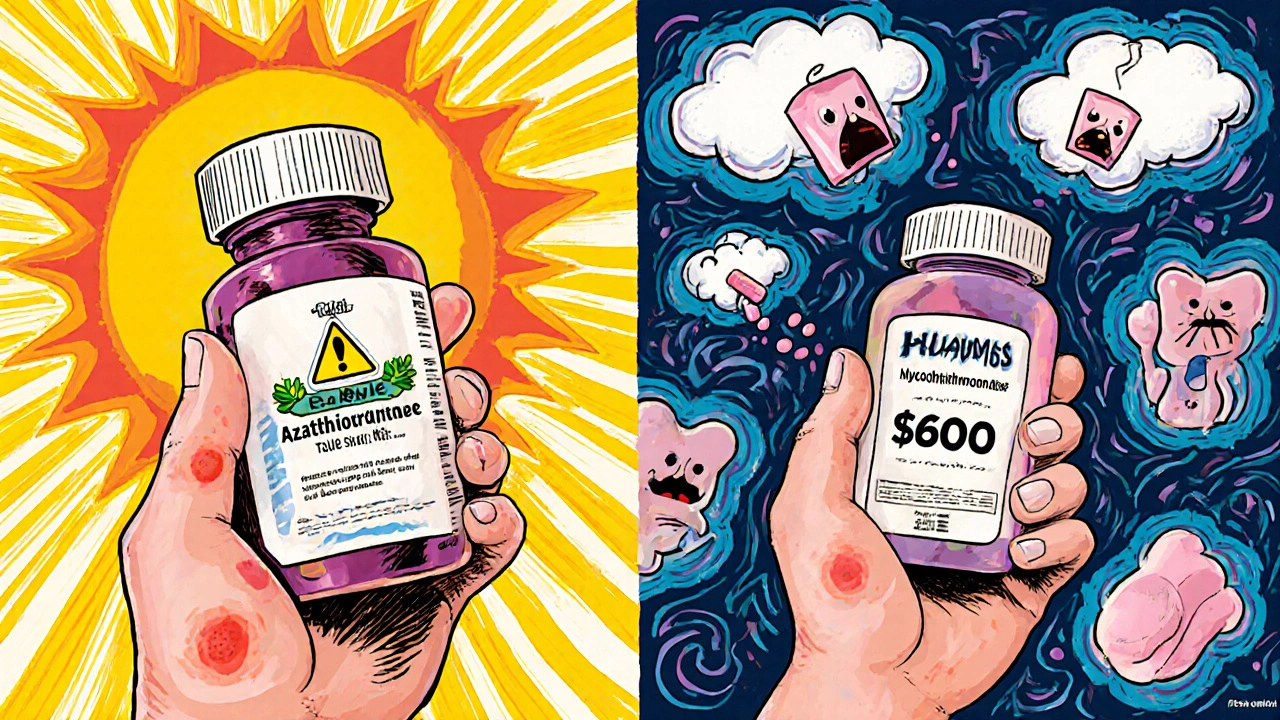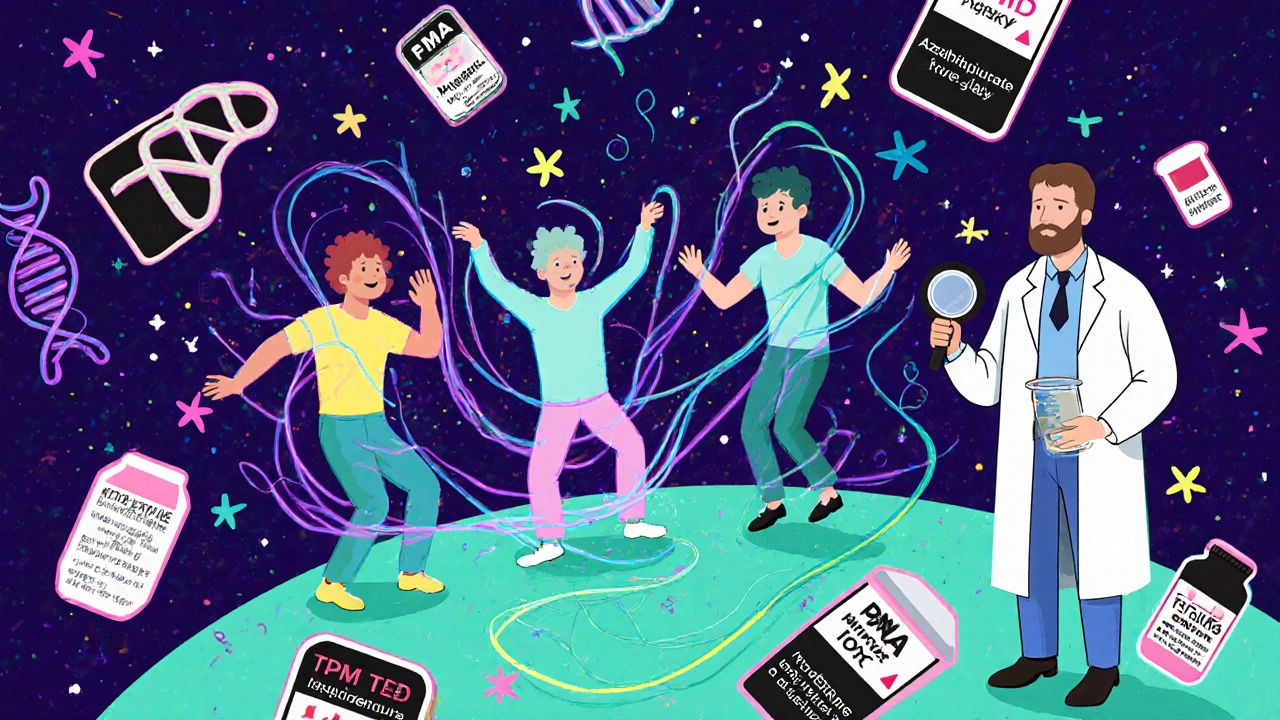Immunosuppressant Drug Interaction Checker
Check Your Medication Safety
Results
Based on medical guidelines and research
When you’re on immunosuppressants like azathioprine or mycophenolate, even small changes in your medication routine can have big consequences. These aren’t ordinary pills. They’re powerful drugs designed to calm your immune system-whether you’ve had a kidney transplant, suffer from lupus, or have autoimmune hepatitis. But they don’t work in isolation. What you take alongside them-other drugs, supplements, even what you eat-can change how they behave in your body. And sometimes, that change can be dangerous.
How Azathioprine and Mycophenolate Work (And Why It Matters)
Azathioprine and mycophenolate both stop your immune system from attacking your new organ or your own tissues. But they do it in completely different ways.
Azathioprine breaks down into 6-mercaptopurine, which then turns into compounds that jam DNA production in fast-growing immune cells. It’s an old drug-approved in 1968-and still used in about 15% of transplant patients today. But it has a hidden vulnerability: your genes. About 1 in 10 people have a version of the TPMT gene that makes them process azathioprine too slowly. If you’re one of them and you take the standard dose, you could end up with dangerously low white blood cell counts-sometimes within weeks. That’s why doctors test your TPMT levels before you even start the drug.
Mycophenolate, on the other hand, blocks a different step in the same pathway. Its active form, mycophenolic acid, shuts down an enzyme called IMPDH, which immune cells need to make purines-the building blocks of DNA. It’s more targeted than azathioprine, which means it doesn’t hit all cells the same way. That’s why it’s now the go-to choice for 70% of kidney transplant patients. It also works better for lupus nephritis, with studies showing over 60% of patients reach remission compared to less than half on azathioprine.
The Big Interactions You Can’t Ignore
These drugs play well with some things and poorly with others. The most dangerous interaction involves azathioprine and allopurinol. Allopurinol is commonly prescribed for gout, but if you take it with azathioprine, your risk of life-threatening bone marrow suppression jumps by more than six times. The reason? Allopurinol blocks the enzyme that normally breaks down azathioprine’s toxic byproducts. Many patients don’t know this until it’s too late. That’s why the FDA put a black box warning on azathioprine labels-this interaction kills.
Mycophenolate has its own tricky partners. Proton pump inhibitors (PPIs) like omeprazole or pantoprazole, which are often prescribed for heartburn, can reduce mycophenolate absorption by up to 35%. That’s a problem if you’re a lupus patient trying to prevent kidney damage. If your drug levels drop, your body may start attacking your kidneys again. Some doctors will switch you to an H2 blocker like famotidine, or increase your mycophenolate dose-but only after checking your blood levels.
Then there’s cyclosporine. It’s a common transplant drug that cuts mycophenolate’s effectiveness by 35-50%. How? It interferes with the way mycophenolate is recycled in your gut. If you switch from cyclosporine to tacrolimus (another transplant drug), your mycophenolate levels can suddenly spike. That’s why doctors monitor drug levels closely during these transitions. One patient on Reddit described it as a “medication dance”-changing one drug forces you to adjust two others, and the timing has to be perfect.
Why One Drug Might Be Better for You
Choosing between azathioprine and mycophenolate isn’t just about what works best in studies-it’s about what works best for you.
If cost is a concern, azathioprine wins. A month’s supply of generic azathioprine costs around $25. Mycophenolate? Around $600. That’s why it’s still used in places like Japan and rural clinics where budgets are tight. But if you’re young, healthy, and can afford it, mycophenolate is usually the smarter long-term choice. It causes fewer bone marrow problems, and studies show patients stick with it better over time.
But mycophenolate has a big downside: your gut. Up to 40% of people on it get diarrhea, nausea, or vomiting. Some switch to the enteric-coated version (EC-MPS), which cuts those side effects by 30%. One transplant patient told a forum: “I tried three different brands before I found one I could keep down.”
Azathioprine’s main issue is sun sensitivity. About 38% of users report severe sunburns after minimal exposure. That’s not just annoying-it increases skin cancer risk. If you’re on azathioprine, you need to be extra careful in the sun, even on cloudy days.

What You Need to Do Right Now
If you’re on either drug, here’s what you need to check:
- For azathioprine: Did you get TPMT tested before starting? If not, ask your doctor. If you’re on allopurinol, stop it immediately and call your prescriber.
- For mycophenolate: Are you taking a PPI? If yes, ask if you can switch to a different heartburn treatment. Take mycophenolate on an empty stomach-at least one hour before or two hours after food. Don’t take it with antacids or iron supplements; wait two hours.
- For both: Get regular blood tests. Watch for signs of infection (fever, sore throat), unusual bruising, or persistent diarrhea. These aren’t just side effects-they could be early warnings.
Therapeutic drug monitoring (TDM) isn’t routine for azathioprine, but it’s recommended for mycophenolate in high-risk patients. The target blood level for mycophenolate is 30-60 mg·h/L. If you’re in a transplant center, they should be tracking this. If you’re not sure, ask.
What’s Changing in 2025
The field is moving fast. In 2023, a new delayed-release version of mycophenolate (Myfortic DR) hit the market, cutting GI side effects by nearly a third. And in 2022, the FDA approved a TPMT genotype-guided dosing calculator that helps doctors pick the right starting dose based on your DNA. Early adopters saw a 37% drop in dangerous low blood counts.
But the biggest shift is cultural. More patients are asking questions. Online communities like r/transplant and patient forums are full of people sharing how they managed diarrhea, switched brands, or got their insurance to cover the more expensive version. This isn’t just about science anymore-it’s about lived experience.
Still, both drugs remain first-line for a reason. Newer agents like voclosporin are gaining ground in lupus nephritis, but they’re costly and not yet widely available. Azathioprine and mycophenolate are proven, affordable, and understood. The key isn’t choosing one over the other forever-it’s knowing how to use them safely, adjust them when needed, and recognize when something’s wrong.

Frequently Asked Questions
Can I take azathioprine and mycophenolate together?
Most guidelines advise against combining them because of increased risk of bone marrow suppression and infection. However, some patients who don’t respond to one drug may be switched to the other, not taken together. If your doctor suggests combining them, make sure they’re monitoring your blood counts weekly and have a clear reason for doing so.
Does mycophenolate cause weight gain?
Mycophenolate itself doesn’t cause weight gain. But many patients gain weight because they’re also on corticosteroids like prednisone, which do. Some report increased appetite after starting mycophenolate, but this is likely due to improved health and reduced inflammation-not the drug directly.
How long does it take for azathioprine to work?
Azathioprine can take 6 to 12 weeks before you see full effects. That’s why doctors often start it alongside faster-acting drugs like corticosteroids. Don’t stop it if you don’t feel better right away. The benefits build slowly, and stopping too soon can cause a flare-up.
Is mycophenolate safe during pregnancy?
No. Mycophenolate carries a high risk of birth defects-nearly 50% higher than azathioprine. The FDA requires two negative pregnancy tests before starting it, and women must use two forms of contraception. If you’re planning pregnancy, talk to your doctor about switching to azathioprine, which is considered safer in pregnancy.
Why do I need to take mycophenolate on an empty stomach?
Food, especially high-fat meals, can reduce how much mycophenolate your body absorbs by up to 25%. That means less drug reaches your immune cells, which could lead to rejection or flare-ups. Taking it on an empty stomach ensures consistent absorption. If you get sick to your stomach, talk to your doctor about switching to the enteric-coated version.
What should I do if I miss a dose of mycophenolate?
If you miss a dose, take it as soon as you remember-if it’s within a few hours. If it’s close to your next dose, skip it. Don’t double up. Missing doses increases your risk of rejection or disease flare. Set phone alarms or use a pill organizer. Many transplant centers provide free apps to help track doses.
Next Steps
If you’re on azathioprine or mycophenolate, schedule a medication review with your pharmacist or doctor. Bring a full list of everything you take-including over-the-counter meds, vitamins, and herbal supplements. Ask: “Could any of these interfere with my immunosuppressant?”
Don’t assume your doctor knows every interaction. Many don’t. Use tools like the University of Liverpool’s Drug Interactions Checker, which is trusted by transplant centers worldwide. Print out your list and go through it together.
And if you’re considering switching from one drug to another-don’t do it on your own. Even small changes need careful planning. The goal isn’t just to stay alive-it’s to live well, without constant side effects or fear of rejection.

Gary Hattis
November 13, 2025 AT 15:31Man, I’ve been on mycophenolate for five years post-kidney transplant. The diarrhea? Total nightmare. I tried every brand-CellCept, Myfortic, even the damn enteric-coated stuff. Ended up switching to taking it at 5 AM on an empty stomach with a big glass of water. No food for two hours after. Changed my life. Also, ditched the omeprazole. Switched to famotidine. No more weird drops in my drug levels. Seriously, if you’re on this stuff, talk to your pharmacist. They know the real tricks.
And yeah, the sun thing with azathioprine? Real. I got a basal cell carcinoma last year. Now I wear UPF 50+ shirts like it’s a fashion statement. Even on cloudy days. Don’t be that guy.
Also, don’t even think about mixing with allopurinol. My buddy died from it. Not a joke.
Esperanza Decor
November 15, 2025 AT 15:11I’m a lupus nephritis patient and mycophenolate saved me. But the GI side effects almost made me quit. I started taking it with a tiny apple-just one slice-and it cut the nausea in half. My doctor was skeptical, but my drug levels stayed in range. Turns out, a little fiber helps your gut handle it better. Also, I swear by magnesium supplements for the cramps. Not a cure, but it helps. Don’t let side effects silence you. There’s always a workaround.
Deepa Lakshminarasimhan
November 17, 2025 AT 08:33They’re hiding something. Why is azathioprine still used if mycophenolate is so much better? Look at the price difference-$25 vs $600. That’s not about science. That’s about Big Pharma pushing the expensive stuff. And don’t get me started on the ‘TPMT test.’ They charge you $800 for it, then bill your insurance. Meanwhile, in India, they just dose by weight and monitor blood counts. No genetic testing needed. Why? Because they don’t care about patents. This whole system is rigged. They want you dependent on the expensive version. Watch your back.
Erica Cruz
November 17, 2025 AT 17:17Wow. This post reads like a drug rep’s PowerPoint. ‘Mycophenolate is the go-to for 70% of transplant patients.’ Really? Where’s the data? Most of those studies are sponsored by Roche. And ‘over 60% remission’? Remission from what? Proteinuria? That’s not cure. And the ‘medication dance’ quote? That’s not insight-that’s a meme. This whole thing is a glossy PR piece disguised as medical advice. If you’re actually on these drugs, you know it’s a crapshoot. No one knows what’s really working. Just keep taking the pills and hope.
Johnson Abraham
November 18, 2025 AT 06:35allopurinol + azathioprine = bad news bears 🚨
my doc never told me. i took both for 8 months. got sick. lost hair. felt like death. blood work showed my wbc was at 1.2. they freaked out. i almost died. now i’m on mycophenolate. still get diarrhea but at least i’m not dead. also, ppi’s? avoid. i took pantoprazole for years. turned out it was killing my drug levels. switched to zantac. life better. also, take it on empty stomach. no excuses. even if you puke, do it. your transplant depends on it. lol.
ps: i miss pizza
Shante Ajadeen
November 20, 2025 AT 00:02Just wanted to say thank you for writing this. I’ve been scared to ask my doctor half the questions here. Like, ‘Should I be worried about my sunburns?’ or ‘Is it normal to feel like crap for 3 weeks after starting?’ I didn’t want to sound dumb. But reading this made me feel less alone. I’m on azathioprine and just got my TPMT results-normal. I’m so relieved. Also, I switched to a sun-protective hat and now I actually go outside. Small wins, right?
You’re helping people. Seriously.